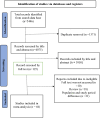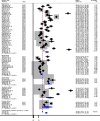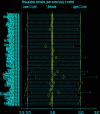Prevalence of diarrheal diseases and associated factors among under five children in Africa: A meta-analysis
- PMID: 40608732
- PMCID: PMC12225826
- DOI: 10.1371/journal.pone.0326501
Prevalence of diarrheal diseases and associated factors among under five children in Africa: A meta-analysis
Abstract
Background: Diarrheal diseases remain a major health threat for children under five in Africa, causing high rates of morbidity and mortality. The regional and continental pooled prevalence and risk factors for childhood diarrhea in Africa remain unknown. This systematic review and meta-analysis (2013-2023) aims to synthesize existing evidence to estimate the pooled prevalence and identify key risk factors associated with childhood diarrhea.
Methods: Searches were conducted in databases including PubMed, Scopus, Web of Science, and Google Scholar to identify research published between January 2013 to December 2023. The PRISMA flowchart guideline was used to screen studies. A random-effects model was used to estimate the pooled prevalence. Publication bias was assessed using a funnel plot and Egger's test, with heterogeneity assessed by I2 statistics.
Results: From the reviewed research, 66 studies met the inclusion criteria and were included in the analysis. The pooled prevalence of diarrheal diseases was 23.59% (95% CI: 21.77-25.42). Sub-group analysis by region revealed the highest prevalence found in Southern Africa (30.14%,) followed by North Africa (28.16%), Central Africa (25.25%), East Africa (24.92%), and West Africa (15.11%). Poor handwashing practices (AOR = 4.69, 95%CI: 2.44-9.04), unimproved water sources (AOR = 1.68, 95%CI: 1.44 1.95), poor solid waste (AOR = 2.29, 95%CI:(1.64 3.20), liquid waste (AOR = 1.72, 95%CI: 1.71-1.723) management, lack of latrine (AOR = 1.17, 95% CI: 1.13-1.22), were significantly associated with DD among under-five children. Conversely, protected water sources (AOR = 0.38, 95% CI: 0.27-0.53), and ventilated improved pit latrines (AOR = 0.85, 95% CI: 0.77-0.95) were protective. Additional risk factors included age (6-11 months: AOR = 1.72, 95% CI:(1.61 1.84);12-23 months: AOR = 2.92, 95% CI:1.60 5.31), lack of exclusive breastfeeding (AOR = 3.06, 95%CI: 2.12-4.43), having more than two under-five children in a household (AOR = 1.48, 95% CI: 1.28-1.71), larger family size (AOR = 2.34, 95% CI: 1.42-3.85), Maternal or caregiver illiteracy (AOR = 2.43, 95%CI: 1.95 3.03), low socioeconomic status (AOR = 1.44, 95%CI: 1.10 1.88) were also significantly associated with DD.
Conclusion: The pooled prevalence of diarrheal diseases among under-five children in Africa was high. Age of a child, lack of exclusive breastfeeding, having more than two children in a household, low socioeconomic status, maternal or caregiver illiteracy, poor hand washing practices, unimproved water sources, poor solid and liquid waste management, absence of a latrine were factors significantly associated with childhood diarrhea. On the other hand, having a ventilated improved pit latrine and getting water from protected sources were protective factors. These findings highlight critical areas for targeted interventions to reduce diarrheal disease in vulnerable African populations.
Copyright: © 2025 Worede et al. This is an open access article distributed under the terms of the Creative Commons Attribution License, which permits unrestricted use, distribution, and reproduction in any medium, provided the original author and source are credited.
Conflict of interest statement
The authors have declared that no competing interests exist.
Figures




Similar articles
-
Does owning improved latrine facilities enhance the safe disposal of child feces in Africa? a systematic review and meta-analysis.PLoS One. 2024 May 16;19(5):e0303754. doi: 10.1371/journal.pone.0303754. eCollection 2024. PLoS One. 2024. PMID: 38753650 Free PMC article.
-
Burden of Childhood Diarrhea and Its Associated Factors in Ethiopia: A Review of Observational Studies.Int J Public Health. 2024 Jun 5;69:1606399. doi: 10.3389/ijph.2024.1606399. eCollection 2024. Int J Public Health. 2024. PMID: 38903206 Free PMC article.
-
Pooled prevalence and associated factors of traditional uvulectom among children in Africa: A systematic review and meta-analysis.PLoS One. 2025 Jan 28;20(1):e0316755. doi: 10.1371/journal.pone.0316755. eCollection 2025. PLoS One. 2025. PMID: 39874381 Free PMC article.
-
Magnitude of postpartum hemorrhage and associated factors among women who gave birth in Ethiopia: a systematic review and meta-analysis.Reprod Health. 2022 Sep 21;19(1):194. doi: 10.1186/s12978-022-01498-4. Reprod Health. 2022. PMID: 36131345 Free PMC article.
-
Utilization of cervical cancer screening and its associated factors among women living with HIV in East Africa: a systematic review and meta-analysis.BMC Womens Health. 2025 Jul 4;25(1):326. doi: 10.1186/s12905-025-03880-3. BMC Womens Health. 2025. PMID: 40616026 Free PMC article.
References
-
- Melese M, Birhan TA, Simegn W, Adugna DG, Diress M, Getawa S, et al. Prevalence of Diarrhea, Intestinal Parasites, and Associated Factors Among Under-Five Children in Dabat District, Northwest Ethiopia: Multicenter Cross-sectional Study. Environ Health Insights. 2023;17:11786302231174744. doi: 10.1177/11786302231174744 - DOI - PMC - PubMed
-
- Mohammed S. Morbidity and Associated Factors of Diarrheal Diseases Among Under Five Children in Arba-Minch District, Southern Ethiopia, 2012. SJPH. 2013;1(2):102. doi: 10.11648/j.sjph.20130102.19 - DOI
-
- Birhan TA, Bitew BD, Dagne H, Amare DE, Azanaw J, Genet M, et al. Prevalence of diarrheal disease and associated factors among under-five children in flood-prone settlements of Northwest Ethiopia: A cross-sectional community-based study. Front Pediatr. 2023;11:1056129. doi: 10.3389/fped.2023.1056129 - DOI - PMC - PubMed
Publication types
MeSH terms
LinkOut - more resources
Full Text Sources
Medical
Miscellaneous

